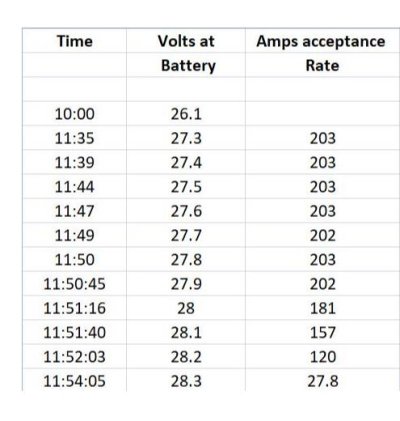Bigger boats with 24 v use more current, smaller boats with 12 v less current, generally, so I can't see how that matters. If you are a liveaboard and plugged in, then you don't need Lithium, or if your cruising is from one dock to another, ditto. An inverter/charger is commonplace on trawlers, where charging is powered by a genset or shore power. If you end up using the genset, then of course less run time is a virtue. How could it not be? And if you are using a genset, then in addition to a fairly common 100 amp charging capacity from the inverter/charger, you can daisy chain Sterling chargers to get extra capacity. That is how I get 180 amps without the CAT running.
My installation used everything I already without modification, so was essentially drop in. I chose to add additional charging capacity, which was about a three hour job. 3,000 charge cycles from now, and a few thousand hours less genset runtime I'll let you know whether I'm still happy, because that would be the minimum lifespan I would expect.
The idea of reducing generator run time for many with a 12 volt charging system and “standard” inverter/chargers made by folks like magnum, outback, Xantrex is in my opinion not reality, and here is why.
Lets take my battery bank and charging setup, as it is pretty typical, and it represents the largest charger that I have seen on a 12V boat.
My FLA L16 batteries are rated by the manufacturer for bulk charging at 100 amps. My bank consists of four batteries in a series parallel configuration equaling 860 amp hours. Since I have a series parallel setup my max charging current is now 200A
My charger is rated at 150 amps, and in addition to that while cruising I have a 150 amp BALMAR alternator.
My loads are averaging between 30 and 50 amps DC at any given time. This is the reality of my 47’ Bayliner running all LED lighting, three fridges/freezers, icemaker, and three displays for the navigation system, plus my KVH VSAT system.
With this setup which again represents equal to or larger than the largest charging capability I have seen on a 12 volt boat I do not exceed the 200 amps of maximum charging current into my batteries. That is if I am running Both my generator and my main engine, which is not how I generally run.
If I just run my generator my 150 amp charger maxes out at around 120 amps of actual battery current.
Going to a LIFEPO4 solution would NOT help unless I bought another high capacity charger and ran it in parallel.
Yes theoretically when my bank reaches about 85% charge my chargers go from bulk to constant current mode, and that might reduce my generator run time a little, but in reality most boaters, (myself included) do not run their generator long enough just to charge batteries in the constant current mode. They generally just chase the approx 50 to 85% window.
You posted that your FLA battery system was over 1300AH at 24 volts.
I would submit that if your rating of your old battery bank is correct then you never exceeded your charge acceptance capacity with your 180 amp charger capacity either, and therefore going to LIFEPO4 technology would not reduce your generator run time significantly.
I might stand corrected on that last statement as I do not know your exact FLA battery configuration, but I do not think so as I thought out how you would build a 1300 amp hour bank at 24 volts pretty extensivly.

